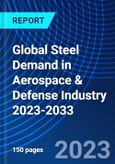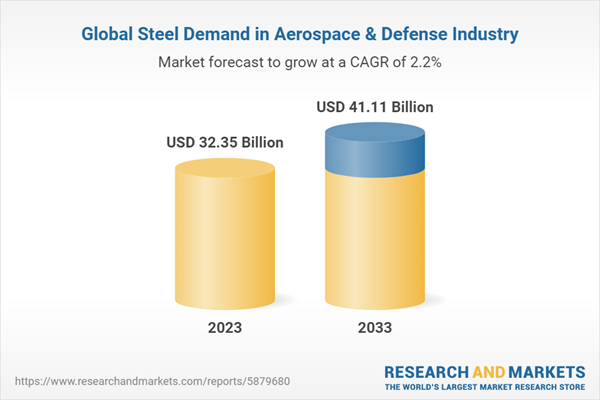Steel components play a vital role in the aerospace and defense industry and are often used alongside other materials like aluminum, titanium, and composites. They offer a combination of strength, toughness, and resistance to wear and fatigue that makes them suitable for various critical applications in these sectors.Advancements in Material Science Could Influence the Future Demand for Steel Components
In the aerospace industry, steel is commonly employed in the construction of aircraft landing gear components, such as struts, beams, and axles. These components must withstand high stress and harsh conditions during takeoff and landing, and steel's properties allow them to perform effectively.
Certain critical components in aircraft engines, such as shafts, bearings, and gears, also make use of steel due to its high strength and temperature resistance. These parts must endure extreme operating conditions, and steel provides the necessary reliability and performance.
In the defense sector, steel is utilized in the production of munitions and ammunition components, including gun barrels, casings, and armor-piercing projectiles. The hardness and durability of steel make it suitable for these high-stress applications.
Steel plates are commonly used in the manufacturing of armored vehicles and personal body armor for military personnel. High-strength steel provides effective protection against ballistic threats while maintaining a certain level of mobility.
In certain missile systems, steel components are used in structural parts and guidance systems. The choice of material depends on the missile's intended purpose and performance requirements.
Helicopter rotor hubs and components also make use of steel due to its excellent mechanical properties and fatigue resistance, which are critical for withstanding the cyclic loading experienced by rotor systems.
Steel is extensively used in the construction of naval vessels, including aircraft carriers, destroyers, and submarines, due to its high tensile strength and resistance to corrosion, which are well-suited for the harsh marine environment.
Support structures and infrastructure within the aerospace and defense industry, such as hangars, maintenance facilities, and equipment support platforms, also rely on steel due to its strength and durability, ensuring the stability and longevity of these structures.
While the aerospace industry is experiencing steady growth, with increasing demand for commercial and military aircraft, the trend towards using more composite materials in airframes and the development of advanced alloys might impact the market for steel components in certain applications.
In the defense sector, the demand for steel components remains strong, particularly in armored vehicles, munitions, naval vessels, and helicopter rotor systems. The high-strength and durability characteristics of steel make it a preferred material for applications where protection and robustness are paramount.
Advancements in steel production and processing techniques have resulted in the development of advanced high-strength steels, which may open new opportunities for steel components in aerospace and defense applications.
While materials cost is a significant factor in the aerospace and defense industries, steel remains a relatively economical choice compared to some advanced composites and alloys, making it advantageous for cost-sensitive projects or specific applications.
As the aerospace and defense industries become increasingly focused on sustainability and reducing environmental impacts, the use of lightweight materials like composites and aluminum may gain more traction over traditional steel components due to their potential for fuel efficiency and reduced emissions.
To enhance the performance, durability, and safety of critical components used in military equipment, aircraft, and spacecraft, a wide range of steel processing techniques are employed in defense and aerospace industries.
Heat treatment is one of the most common steel processing techniques used, involving controlled heating and cooling of steel to achieve specific mechanical properties. Annealing, quenching, tempering, and solution treatment are common heat treatment processes used in aerospace and defense.
Precision machining is another essential technique in manufacturing critical aerospace parts, where tight tolerances and complex geometries are required. Precision machining ensures the components fit together accurately and function seamlessly, contributing to the overall reliability and performance of the aerospace systems.
Welding is extensively utilized in defense and aerospace to join steel pieces and fabricate complex structures. Various welding techniques, including gas tungsten arc welding (GTAW), gas metal arc welding (GMAW), and electron beam welding (EBW), are employed based on specific application and material requirements.
Surface treatments are crucial in enhancing the properties of steel components used in defense and aerospace. Shot peening induces compressive stresses, improving fatigue resistance, while surface plating and coatings provide corrosion resistance, reducing the degradation of steel components exposed to harsh environmental conditions.
Steel alloys play a significant role in aerospace and defense due to their exceptional properties, such as high strength, durability, and resistance to extreme conditions. Stainless steel, maraging steel, armor steel, and high-strength low-alloy (HSLA) steel are some of the steel alloys used in these industries.
Stainless steel, containing a minimum of 10.5% chromium, offers excellent corrosion resistance, making it suitable for aircraft structures exposed to harsh environmental conditions. Maraging steel provides remarkable strength-to-weight ratio and toughness, ideal for aerospace applications.
Armor steel is designed to withstand high-velocity impacts and is widely used in armored vehicles, body armors, and military shelters. HSLA steel combines high strength with improved weldability and formability, finding application in both aerospace and defense.
Superalloys, containing nickel, cobalt, and chromium, are crucial for aerospace propulsion systems, such as gas turbine engines and rocket nozzles, as they can withstand high temperatures and stresses.
Steel alloys are also used in aerospace bearings, landing gear systems, and precision machining of critical components. They play an essential role in providing reliable performance and safety in aerospace and defense applications.
Several factors drive the use of steel components in the aerospace and defense industries, including their exceptional strength, durability, reliability, and cost-effectiveness. Steel's long history of successful use in these sectors has established a strong foundation of trust, making it a preferred material for certain mission-critical components.
Trends influencing the steel components market size include advances in technology, such as the development of new materials and manufacturing techniques, and the increasing demand for defense aircraft engines. However, the future of the steel components market in aerospace and defense will depend on how these dynamics evolve over time.
Overall, steel components remain crucial for various applications in the aerospace and defense industries, providing essential properties that contribute to the reliability, durability, and performance of critical systems in these sectors.
Table of Contents
Access Control Market Report DefinitionExpert Opinions on Access Control Market ReportConclusions
Access Control Market Segmentation
Access Control Market Analysis for next 10 Years
Market Technologies of Access Control Market
Global Access Control Market Forecast
Regional Access Control Market Trends & Forecast
Country Analysis of Access Control Market
Opportunity Matrix for Access Control Market
Table Information
| Report Attribute | Details |
|---|---|
| No. of Pages | 150 |
| Published | September 2023 |
| Forecast Period | 2023 - 2033 |
| Estimated Market Value ( USD | $ 32.35 Billion |
| Forecasted Market Value ( USD | $ 41.11 Billion |
| Compound Annual Growth Rate | 2.2% |
| Regions Covered | Global |









